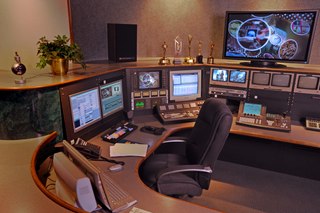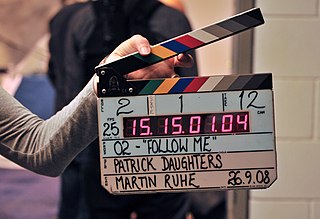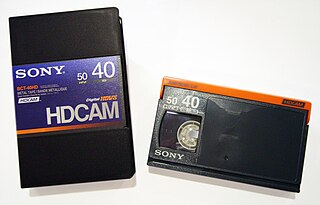
Video is an electronic medium for the recording, copying, playback, broadcasting, and display of moving visual media. Video was first developed for mechanical television systems, which were quickly replaced by cathode-ray tube (CRT) systems, which, in turn, were replaced by flat-panel displays of several types.
CBS Broadcasting Inc., commonly shortened to CBS, is an American commercial broadcast television and radio network serving as the flagship property of the CBS Entertainment Group division of Paramount Global.

Non-linear editing is a form of offline editing for audio, video, and image editing. In offline editing, the original content is not modified in the course of editing. In non-linear editing, edits are specified and modified by specialized software. A pointer-based playlist, effectively an edit decision list (EDL), for video and audio, or a directed acyclic graph for still images, is used to keep track of edits. Each time the edited audio, video, or image is rendered, played back, or accessed, it is reconstructed from the original source and the specified editing steps. Although this process is more computationally intensive than directly modifying the original content, changing the edits themselves can be almost instantaneous, and it prevents further generation loss as the audio, video, or image is edited.

SMPTE timecode is a set of cooperating standards to label individual frames of video or film with a timecode. The system is defined by the Society of Motion Picture and Television Engineers in the SMPTE 12M specification. SMPTE revised the standard in 2008, turning it into a two-part document: SMPTE 12M-1 and SMPTE 12M-2, including new explanations and clarifications.

Kinescope, shortened to kine, also known as telerecording in Britain, is a recording of a television program on motion picture film, directly through a lens focused on the screen of a video monitor. The process was pioneered during the 1940s for the preservation, re-broadcasting and sale of television programs before the introduction of quadruplex videotape, which from 1956 eventually superseded the use of kinescopes for all of these purposes. Kinescopes were the only practical way to preserve live television broadcasts prior to videotape.

Helical scan is a method of recording high-frequency signals on magnetic tape, used in open-reel video tape recorders, video cassette recorders, digital audio tape recorders, and some computer tape drives.
Face the Nation is a weekly news and morning public affairs program airing Sundays on the CBS radio and television network. Created by Frank Stanton in 1954, Face the Nation is one of the longest-running news programs in the history of television.

ARD is a joint organisation of Germany's regional public-service broadcasters. It was founded in 1950 in West Germany to represent the common interests of the new, decentralised, post-war broadcasting services – in particular the introduction of a joint television network.

Kukla, Fran and Ollie was an early American television show using puppets. It was created for children, but was soon watched by more adults than children. It did not have a script and was entirely ad-libbed. It was broadcast from Chicago between October 13, 1947, and August 30, 1957. Comedienne Fran Allison starred, interacting with puppets, Kukla and Ollie whose puppeteer was the show's creator, Burr Tillstrom. After the original run, the team appeared in other productions over several decades.

720p is a progressive HD signal format with 720 horizontal lines/1280 columns and an aspect ratio (AR) of 16:9, normally known as widescreen HD (1.78:1). All major HD broadcasting standards include a 720p format, which has a resolution of 1280×720p.

1–inch Type C is a professional reel-to-reel analog recording helical scan videotape format co-developed and introduced by Ampex and Sony in 1976. It became the replacement in the professional video and broadcast television industries for the then-incumbent 2–inch quadruplex videotape open-reel format. Additionally, it replaced the unsuccessful type A format, also invented by Ampex, and, primarily in mainland Europe, it supplemented the type B format, invented by the Fernseh division of Bosch.

HDCAM is a high-definition video digital recording videocassette version of Digital Betacam introduced in 1997 that uses an 8-bit discrete cosine transform (DCT) compressed 3:1:1 recording, in 1080i-compatible down-sampled resolution of 1440×1080, and adding 24p and 23.976 progressive segmented frame (PsF) modes to later models. The HDCAM codec uses rectangular pixels and as such the recorded 1440×1080 content is upsampled to 1920×1080 on playback. The recorded video bit rate is 144 Mbit/s. Audio is also similar, with four channels of AES3 20-bit, 48 kHz digital audio. Like Betacam, HDCAM tapes were produced in small and large cassette sizes; the small cassette uses the same form factor as the original Betamax. The main competitor to HDCAM was the DVCPRO HD format offered by Panasonic, which uses a similar compression scheme and bit rates ranging from 40 Mbit/s to 100 Mbit/s depending on frame rate.

Digital cinematography is the process of capturing (recording) a motion picture using digital image sensors rather than through film stock. As digital technology has improved in recent years, this practice has become dominant. Since the mid-2010s, most movies across the world are captured as well as distributed digitally.
This glossary of terms used in broadcasting is a list of definitions of terms and concepts related to both radio and television broadcasting, along with the industry in general.

Sony HDVS is a range of high-definition video equipment developed in the 1980s to support an early analog high-definition television system thought to be the broadcast television systems that would be in use today. The line included professional video cameras, video monitors and linear video editing systems.
In broadcasting, channel playout is the generation of the source signal of a radio or television channel produced by a broadcaster, coupled with the transmission of this signal for primary distribution or direct-to-audience distribution via any network. Such radio or television distribution networks include terrestrial broadcasting, cable networks, satellites, IPTV, OTT Video, point-to-point transport over managed networks or the public Internet, etc.
Blackbird is an integrated internet video platform, video editing software, covering non-linear editing and publishing for broadcast, web and mobile.

Taiwan Television Enterprise, Ltd., commonly known as TTV and formerly known as Central Television and Voice of Taiwan, is the first terrestrial television station in Taiwan. It was established on April 28, 1962, and started formally broadcasting later that year on October 10, 1962, as free-to-air. It is the first television company in Taiwan.
High-definition television (HDTV) describes a television or video system which provides a substantially higher image resolution than the previous generation of technologies. The term has been used since at least 1933; in more recent times, it refers to the generation following standard-definition television (SDTV). It is the current de facto standard video format used in most broadcasts: terrestrial broadcast television, cable television, satellite television.

Lost television broadcasts are mostly those early television programs which cannot be accounted for in studio archives usually because of deliberate destruction or neglect.














